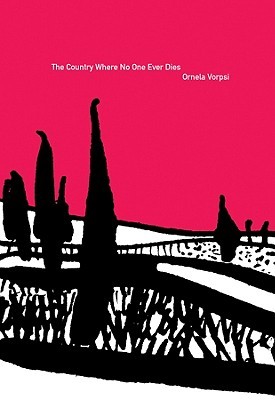Memories of an Albanian childhood supply the collection of vignettes that amount to Ornela Vorpsi’s debut, The Country Where No One Ever Dies (2005), translated from the Italian by Robert Elsie and Janice Mattie-Heck in 2009. Despite having the hint of autobiography, it’s more a fragmented novel, if it’s a novel at all, whereby the vignettes shift between a range of girls, but with a sense there’s some sort of shared experience between them.
The sketched moments touch on aspects of life in the 1970s, with Vorpsi maintaining a steady distance that allows her adult reflection to add both clarity to childish naïveté and an acerbic commentary on the Stalinist regime. Memories of school with partisan teachers and bunking off military practice for the afternoon are here, as are many incidents that relate to two Albanian obsessions: death and fornication, the latter the “quintessence of their existence”:
They take endless delight in the subject. Their hearts burn with it (though, really, Albanian hearts can ignite just about anything). Everyone is completely preoccupied , young and old, educated and illiterate, to the point where they even begin to hallucinate.
In many cases sex and death are entwined. Within the communist dream of public ownership there is a patriarchal conflict (“Men have a highly developed sense of private property in this country.”) and the universal maxim is that women are intrinsically whores. The actions therefore of women who come out from the bushes with swollen bellies leads often to tragic consequences via illegal abortions or other, more common means.
As far as I’m aware, men never jump into the water here — or, lets put it this way, Albanian men don’t really suffer too much from lovesickness. They find other solutions. And of course, they also don’t get pregnant, and so aren’t forced into such drastic measures.
In this isolated world one place that escape can be achieved from “the sense of eternity that infects my country” is within books. Fairy tales, Shakespeare, and Russian classics. In one book (“perhaps Maupassant”) some girls read something they have difficulty believing about a young woman’s panic (“And men knew what this bleeding meant.”). However, even within literature the same truths appear about patriarchy, and there’s also no escape within other arts, as when contemplating Delacroix’s Liberty Leading The People and her exposed breasts.
So, why didn’t the shirt slide off one of the men instead? Why was she in the middle of the painting? It was the eternal story of men and women, even at the height of a revolution.
Although Vorpsi’s Albania oozes misery and its feminist take finds universal inequalities in a poor country kidding itself that it’s the envy of the world. The Country Where No One Ever Dies is also full of irony, between the young girls’ understanding versus the mature author’s, and in mocking the regime’s message, such as when one girl’s father disappears.
He wasn’t a political prisoner, though — just a common criminal — and so posed no danger to society.
While mocking, there’s also a sense of nostalgia, perhaps not for the way of life, but for the people characterised throughout. A homesickness brought about by reflection, having escaped “my fate, predetermined by the State”. The characters that pass through the pages are varied and they bring moments of joy, confusion, poignancy, and in the case of the main girl’s grandfather, a humour in how it was all so much better under the fascists.
The many vignettes capture life and its struggles in a land of beauty and brutality, but there’s a sense that there’s more out there, a better glue to pull it all together. The flitting between different girls is somewhat confusing — unexpected, even — especially as little changes in their tone. But it’s an interesting work in how it finds a connection between totalitarian and patriarchal control, although its seems to report back without exploring this further.
